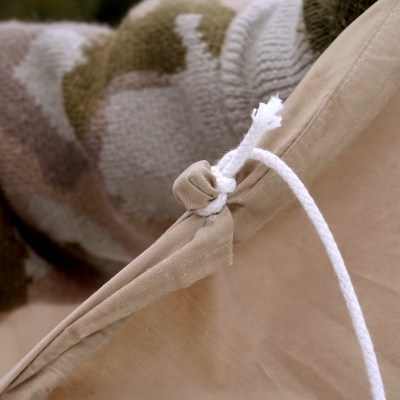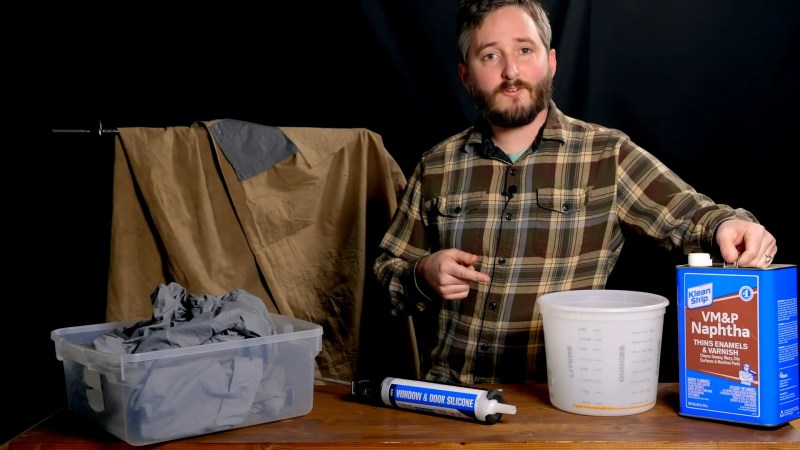For hackers in the Northern Hemisphere, the seasons of wet and cold are upon us. Staying dry is every bit as important as staying warm, so what better than a hack or two to keep us warm and dry! All you’ll need is a bed sheet, some rope, and a run to the local hardware store, and a bit of knowledge. [NightHawkInLight] has us covered with the excellent video “Recycled Bedsheets Make The Best Waterproof Tarps” as seen below the break.
 [NightHawkInLight] brings old traditional methods into the 21st century by turning away from oil, beeswax and canvas in favor of a recycled bed sheet made waterproof with silicone. The video goes into just enough detail so that you can reproduce their results without fear of working with the powerful solvent being used.
[NightHawkInLight] brings old traditional methods into the 21st century by turning away from oil, beeswax and canvas in favor of a recycled bed sheet made waterproof with silicone. The video goes into just enough detail so that you can reproduce their results without fear of working with the powerful solvent being used.
Cheap hardware store grade silicone sealant is thinned by naphtha, worked into the old bed sheet, and then hung out to dry overnight. The result? A perfectly waterproof sheet that’s just as pliable as before treatment. But how can you use it like a tarp, when there are no eyelets? If you watch the video for no other reason, check out the neat attachment trick at the end, where traditional technology is brought to the fore once again with nothing more than a rock and a slip knot.
We can imagine that the uses for such inexpensive, durable home made tarps are many. Perhaps one could put it to use when building your own Custom Cycling Camper.















” But how can you use it like a tarp, when there are no eyelets?”
Grommet tool kit. Not expensive either.
He makes a great point in the video that a grommet kit tears the fibers, weakening the attachment point significantly. It’s a good point.
The right answers is tarp clamps. They pressure-fit around any material, and are honestly the coolest thing for any fabric or tarp hanging. I use them for projection screens.
I came here to propose the same thing, I am also using them for projection screens :D
Nice projection art btw
Thank you for the tip. Never heard of these and that is something I could have some good uses for.
That’s why you roll the edge before putting in a grommet. Same as when making holes for clothes with lace-up grommets. I would even roll and stitch the edges before waterproofing and then put in the grommets.
I use sheet bend knots. Especialy in corners of the tarp it does work really well. Never tried it in the middle of the tarp. You can even use it to make diy hammock. Just fold sheet material in accordion-like manner and then attach ropes to the ends using sheet bend knot.
Naphta is banned in multiple place in the world. I guess White spirit will work as well.
While not being naphta, lighter fluid (zippo fluid) might do the job as well.
Zippo fluid IS mostly naphtha.
Xylene is comparable afaik.
Naptha with additives/bitterants that make it lousy for drug-making. (Why Naptha is generally banned)
be careful with xylene i would test it out on any material you are thinking of doing this to as it likes to melt lots of things. it is a very good solvant :)
this is a fun little trick to do to get a nice tarp just be aware it does not breathe after you do this. so it is great for waterproofing but if you use something like this over a tented area the condensation will gather because it does not breathe
Toluene has similar properties to Xylene but has a lower boiling point so would evaporate more quickly.
or Kerosene (Paraffin in some places)
The same method was used by [Skill Tree] to make a backpack that turns into a tent.
https://www.youtube.com/watch?v=SM7TQi1IHJk
Shoe waterproofing sprays work similarly – it’s either silicone in solvent, or paraffin wax in solvent.
Just don’t use them indoors – or at least spray the stuff under a vinyl bag – your lungs will not feel well after inhaling even a little bit.
But what if I want to waterproof my lungs
1 additional step required: insert your head in said vinyl bag until desired result is achieved
Then I suggest tar for the additional mold and barnacle resistance.
Do it the old fashioned way, tar your lungs with tobacco.
Sounds like a good way to get conformal coating on PCB boards. Mask off all the bits that shouldn’t have coating in them (ie microphones, speakers, the USB connector, or the hole in the sonalert) and dip in solvent dissolved silicone.
That’s like the way that old army tents were made – canvas waterproofed with a medium thinned in a solvent. The vintage stuff was tar or pitch thinned with linseed oil. (Which is where the word tarpaulin came from). Now it’s silicone thinned in a petroleum solvent.
I take issue with the video title though – Recycled bed sheets do not make the best tarps. They might make adequate tarps, and they definitely qualify as a “hack”. One problem is that I only replace my bed sheets when they have either worn thin or have a hole in them. Quality bed sheets aren’t cheap! A second problem is that they are weak. They aren’t designed with a rip-stop thread pattern, so once a ripping force exceeds the thread ultimate strength, the rip is likely to progress across the entire sheet. Most modern camping fabrics are designed with an extra heavy rip-stop thread every 5mm or so to prevent that whist still being lightweight. The third problem is that cotton sheets will rot or mildew if put away damp – even if waterproofed. Anyone with experience of those old army tents knows how much additional care they require compared to tents made from synthetic material
All in all, you’re better off buying rip-stop silnylon from the likes of ripstopbytheroll or dutchware.
Did I understand this right: take silicone, thin with solvent, soak cloth in it, hang up to let solvent evaporate, and then cure the silicone.
Not a bad solution, and probably great in a pinch, but, is it really that much cheaper and better than a store bought one when you consider the consumables and time/effort?
As usual with DIY stuff: no.
But you do get custom tarps in colors and shapes you might not find elsewhere.
Hard to beat the range available at Dutchware though. They have a huge range of print2fabric patterns in a range of waterproofed fabrics (poly, silnylon or mix) suitable for tarps to heavy packs. If you don’t find a pattern to suit, they can work with you to create a custom pattern, and also have contract sewing services.
Anecdotally speaking, it seems like this solution is better than Nikwax. I wonder if it could work on modern day rain flys that are made of polyester without “burning” the fabric or alter it’s structural integrity (stiffening or causing tears)
I think not, you wouldn’t want to use a strong solvent on synthetic fiber textiles (instead of cotton sheets).
My guess is the solvents that effectively thin silicone will not play well with polyester. It’s normally petrol based stuff that you don’t want to breath, like naphtha.
I know Smooth On has a silicone thinner solvent that might be gentler, but, it would probably cost a ton of money for the volume needed for this.
Fair play. I’d def wouldn’t want to experiment on my rain fly lol
I wonder if this is better or worse for the environment than landfilling the sheet and buying a synthetic tarp? Seems like a lot of solvent in the air and a lot of silicone, compared to just some thin ripstop nylon or whatever tarp you choose.
Yaay, NightHawkInLight finally caught on with this hack. That was used for somewhat around twenty years (!!!) by fishermen and campers for waterproofing tents and tarps on the cheap. Yes, this very exact variety, silicone caulk thinned with solvent.
Oldest known article on the topic (known to me) is by Jim Wood, on now defunct jwbasecamp.com:
https://web.archive.org/web/20051019061021/http://jwbasecamp.com/Articles/Silnylon1/index.html
Don’t get me wrong — I really like NightHawkingLight’s channel, quality videos and good production. Just in this particular case there’s no novelty — but not a word said in the video that this trick is really old yarn, used by our dads.
I’ve done this using mineral spirits for the solvent. You’ve got to mix it pretty enthusiastically. He doesn’t explicitly say that what you’re looking for is the old-school Silicone I and not the fancy new Silicone II.
I’ve waterproofed outdoor gear that was leaking at the seams or just was not adequately waterproof from the factory. Generally good results.
In a pinch you could put that solution in an empty water bottle and shake vigorously. For clarity, what materials (nylon, polyester, canvas, cotton) have you water proofed?
Cool trick. Reminds me of when I saw a site that was selling large canvas fabric patterns that you stretch over a frame and spray down with water. The fabric had cement/grout/plaster impregnated in the fibers and once it sets secured to the ground formed a waterproof/semi permanent structure for military forward posts or base camps for climbers. I like the concept.
I’ve done this with my tarp many years ago, worked great until it caught fire, which was fully my fault. Was a thin cotton that I used. currently have a “fancy” (still cheap) one with alu foil on the inside that reflects the heat better. But these tarps are still great and with a thin cotton it’s compact and lightweight, which is nice.